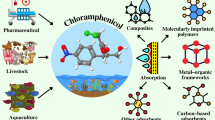Abstract
Mildiomycin (MIL) is a novel nucleoside agro-antibiotic which shows a specific and strong inhibitory activity against fungi, especially, powdery mildews. Because of its low action dosage, excellent environmental compatibility and remarkably low toxicity to human and animals, MIL is regarded as a kind of green biological pesticides. In this paper, the recovery and purification of MIL from fermentation broth were investigated by ion-exchange separation technique. The ion-exchange properties of MIL on HZ110™ resin, including ion-exchange equilibrium and dynamics in column process, were discussed. Results showed that the equilibrium exchange capacity of MIL was 26.5 mg per gram of wet resin at optimal pH value of pH 7.0. Ion-exchange isotherms of MIL can be well correlated with Freundlich equation. The ion-exchange capacity increased with raising the temperature. In the dynamic column process, breakthrough capacity was 29.3 mg per gram of wet resin. According to the ratio of desorption and eluent concentration of MIL, 2% ammonia aqueous solution was chosen as the eluent. And the total recovery ratio of MIL in ion-exchange process was up to 94.5%, and the enriched factor was about 8.
Similar content being viewed by others
References
Chen, Y., Xu, Z. N., Shen, W. H. and Cen, P. L., “Contents determination of Anganmycin by RP-HPLC in the broth,” Chinese J. Pestic., 43, 117 (2004).
Chen, Y., Xu, Z. N., Shen, W. H., Lin, J. P. and Cen, P. L., “The ion-exchange kinetics of SAM+/H+ system with JK110 resin,” Korean J. Chem. Eng., 22, 121 (2005).
Harada, S. and Kishi, T., “Isolation and characterization of mildiomycin, a new nucleoside antibiotic,” J. Antibiot., 6, 519 (1978).
He, B. L. and Huang, W. Q., Ion-exchange and adsorption resin, Shanghai Scientific and Technological Education Press, Shanghai (1995).
Kishimoto, K. and Akiyama, S., “Stimulatory effect of ferrous ion on mildiomycin production by Streptoverticillium rimofaciens,” Biotechnol. Lett., 19, 699 (1997).
Mujeebur, R. K. and Wajid, M. K., “Effects of sulfur dioxide on the development of powdery mildew of cucumber,” Environ. Exp. Bot., 40, 265 (1998).
Reuveni, M. and Cohen, H., “Polar-a potent Polyoxin B compound for controlling powdery mildews in apple and nectarine trees, and grapevines,” Crop Prot, 19, 393 (2000).
Seung, J. K., Sung, Y. C. and Tae, Y. K., “Adsorption of chlorinated volatile organic compounds in a fixed bed of activated carbon,” Korean J. Chem. Eng., 19, 61 (2002).
Suzuki, T. and Sawada, H., Method for producing mildiomycin, US patent, 4334022 (1982).
Takeda Pharmaceutical Company Limited, “Summary of toxicological studies on mildiomycin,” J. Pestic. Sci., 19, 135 (1994).
Author information
Authors and Affiliations
Corresponding author
Rights and permissions
About this article
Cite this article
Chen, Y., Qu, H., Xu, Z. et al. Ion-exchange properties of mildiomycin on HZ110™ resin. Korean J. Chem. Eng. 23, 991–996 (2006). https://doi.org/10.1007/s11814-006-0019-x
Received:
Accepted:
Issue Date:
DOI: https://doi.org/10.1007/s11814-006-0019-x




